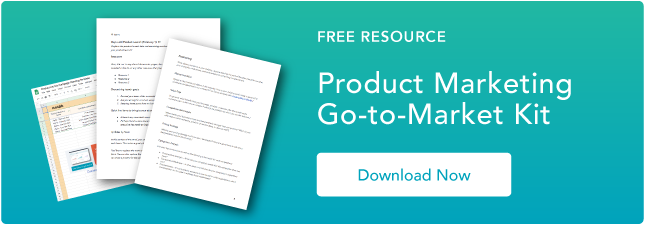When I was 12 years old, I used to be confused about my cousin’s CD collection. Why have CDs when I could go on iTunes and listen to all my favorite songs? This is a perfect example of a product life cycle (PLC) in action.
When I was 12 years old, I used to be confused about my cousin’s CD collection. Why have CDs when I could go on iTunes and listen to all my favorite songs? This is a perfect example of a product life cycle (PLC) in action.
No one wants their product to become “obsolete” and reach the end of its product life cycle. That’s why it’s important to understand what stage your product is in so you can make better marketing and business decisions.
Below, we’ll learn about the product life cycle inside and out. If you’re in a pinch, use the links below to jump straight to what you need:
- What is the product life cycle?
- What are the stages of the product life cycle?
- Importance of the Product Life Cycle
- Breaking Down the Product Life Cycle Theory
- Product Life Cycle Marketing Strategies
- Product Life Cycle Examples
- International Product Life Cycle
- When to Use the Product Life Cycle
In the marketing industry, the typical depiction of the product life cycle only has four main stages — Introduction, Growth, Maturity, and Decline. At HubSpot, we agree that these are vital for a product, but the two stages “Development” and “Decline” aren’t nearly covered enough.
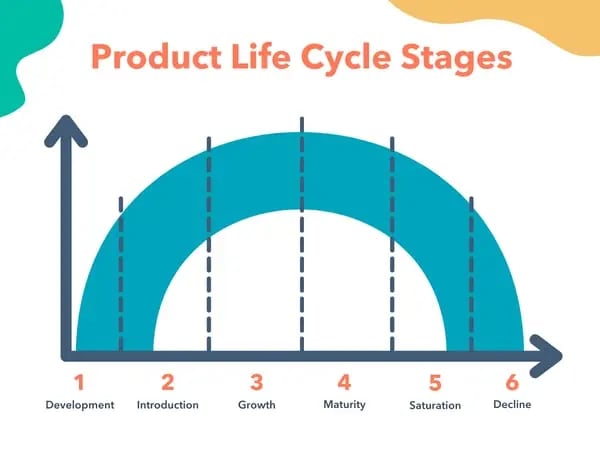
As marketers, it’s important to understand how your tactics and strategies change depending on the stage your product is in. Let’s break down each of the six stages of the product life cycle.
1. Development
The development stage of the product life cycle is the research phase before a product is introduced to the marketplace. This is when companies bring in investors, develop prototypes, test product effectiveness, and strategize their launch.
In this stage, companies typically spend a lot of money without bringing in any revenue because the product isn’t being sold yet.
This phase can last for a long time, depending on the complexity of the product, how new it is, and the competition. For a completely new product, the development stage is particularly difficult because the first pioneer of a product isn’t always as successful as later iterations.
Before full-scale production, the product may be released in a limited market or region for testing purposes. This allows companies to assess market acceptance, gather user feedback, and make necessary adjustments before a wider launch.
2. Introduction
The introduction stage happens when a product is launched in the marketplace. This is when marketing teams begin building product awareness and targeting potential customers. Typically, when a product is introduced, sales are low and demand builds slowly.
In this phase, marketers focus on advertising and marketing campaigns. They also work on testing distribution channels and building product and brand awareness.
This stage is crucial because companies have the opportunity to shake up the status quo and capture the attention and loyalty of early adopters. The positive experiences and word-of-mouth recommendations from these early customers can influence the broader target market and accelerate product adoption.
Some examples of products currently in the introduction stage include:
- Generative AI
- Self-driving cars
- 3D televisions
Ultimately, the success of this stage sets the foundation for the product’s future growth and success in subsequent stages of the product life cycle.
3. Growth
During the growth stage, consumers have accepted the product in the market and customers are beginning to truly buy in. That means demand and profits are growing, hopefully at a steadily rapid pace. This momentum is crucial for sustaining business operations, funding further product development, and generating returns on investment.
As companies scale, they can benefit from lower per-unit production costs, improved supplier relationships, and optimized distribution networks.
However, there are some challenges that come with the growth stage. As the market for the product expands, competition grows. Potential competitors will see your success and will want in.
Some products that are currently in the growth stage are:
- Smartwatches
- Electric cars
- Peloton
During this stage, it’s important to keep attracting new customers and solidify your brand image so you can stay ahead of the competition.
4. Maturity
The maturity stage is when the sales begin to level off from the rapid growth period. At this point, companies begin to reduce their prices so they can stay competitive amongst the growing competition. Streamlining production processes, negotiating favorable supplier contracts, and optimizing distribution networks also become important considerations.
This is the phase where a company begins to become more efficient and learns from the mistakes made in the introduction and growth stages. Marketing campaigns are typically focused on differentiation rather than awareness. This means that product features might be enhanced, prices might be lowered, and distribution becomes more intensive.
During the maturity stage, products begin to enter the most profitable stage. The cost of production declines while the sales are increasing.
Examples:
- Smartphones
- Amazon
- Video game consoles
5. Saturation
During the product saturation stage, competitors have begun to take a portion of the market and products will experience neither growth nor decline in sales.
Typically, this is the point when most consumers are using a product, but there are many competing companies. At this point, you want your product to become the brand preference so you don’t enter the decline stage. To achieve this, you’ll want to focus on providing exceptional service and building strong relationships with your customers.
In a saturated market, innovation also becomes essential to stay relevant. Businesses must continuously invest in research and development to improve products and offer new features. Failure to do so may lead to product obsolescence and loss of market share.
Some examples of products in the saturation stage are:
- Streaming services
- Breakfast cereals
- Soft drinks
6. Decline
Unfortunately, if your product doesn‘t become the preferred brand in a marketplace, you’ll typically experience a decline. Sales will decrease during the heightened competition, which is hard to overcome.
Decline also occurs when products become outdated or less relevant as newer technologies enter the market. Consumers may turn to more advanced options, rendering the declining product less desirable.
If a company is at this stage, it’ll either discontinue its product, sell the company, or innovate and iterate on its product in some way.
Here are a few examples of products in the decline stage:
- CDs and cassette tapes
- Landline telephones
- DVDs
The best companies will usually have products at several points in the product life cycle at any given time. Some companies look to other countries to begin the cycle anew.
Importance of the Product Life Cycle
The product life cycle is important because it informs an organization’s management and decision-makers how well a product is performing and what strategic actions it will take to succeed. This helps companies allocate resources like staff, budgets, shows which products should be prioritized, and where the company should innovate next.
Other benefits of using the product life cycle include:
- Make better marketing investments and decisions
- Easier to make long-term plans
- Allows for better decision making with accurate information on performance
- Easier to streamline current processes within your company
Product Life Cycle Limitations
While using the PLC method certainly helps stakeholders plan, it does have limitations. The cycle breaks down performance over several stages, but unfortunately there is no way to tell how long each stage will last.
Complicating things further, not all products will move through these stages at the same pace. For example, a product may take longer to decline than others. Plus product managers run the risk of not dedicating enough effort and resources into a particular product if they think the product will decline, creating planned obsolescence – even if customers still use it.
Breaking Down the Product Life Cycle Theory
In the late ‘60s, Harvard Business School professor Raymond Vernon developed this marketing theory in response to an economic model that failed to account for trends present in international trade – that’s why it was originally called the international product life cycle theory.
It stated that products developed in an international market had three phases:
- New product
- Maturing product
- Standardized product
Here’s a quick breakdown of his theory.
Vernon theorized a new product would perform best in its country of origin to keep manufacturing and production costs low. Once the product gained demand, companies could begin exporting to other countries and continue building local production plants in each new location.
Having these local plants would offer the flexibility to make changes to the product without incurring huge costs.
The standardized phase would involve an influx of competitors, which would lead the company to focus on driving down production and manufacturing costs to remain competitive. As the market becomes saturated and a new product gets introduced, the company loses its relevance in its home country and shifts gears to create something new, with the cycle beginning again.
Since then, the product life cycle theory has evolved to focus less on geography and more on marketing. Let’s dive into it next.
You can use this template to map out your own product’s life cycle phases.
Download the Free Product Life Cycle Template
Product Life Cycle Marketing Strategies
Now that we’ve discussed the different stages of the product life cycle, let’s explore how to market products in each stage.
Development Stage Marketing Strategy
While marketing typically begins in the introduction stage, you can begin to build “buzz” around your product by securing the endorsement of established voices in the industry.
You can also consider a limited release of the product to a select group of customers or in a specific market segment. This exclusivity can create a sense of anticipation and urgency among potential buyers.
Then, you can use the feedback from the limited release to publish early (and favorable) consumer research or testimonials. Your marketing goal during this stage is to build upon your brand awareness and establish yourself as an innovative company.
Introduction Stage Marketing Strategy
This is where the fun begins. Now that the product is launched, you can actually promote it using inbound marketing and content marketing.
Consider collaborating with influencers or industry experts who have a strong following and influence in your target market. Encourage them to review and promote your product through blog posts, vlogs, social media posts, or sponsored content. Their endorsement can help generate credibility and reach a wider audience.
Education is vital in this stage. If your marketing strategies are successful, the product goes into the next stage — growth.
Growth Stage Marketing Strategy
During this phase, marketing campaigns often shift from getting customers’ buy-in to establishing a brand presence so consumers choose them over developing competitors.
One way to do this is by allocating resources to digital marketing channels like social media advertising, search engine optimization (SEO), content marketing, and influencer partnerships. Then, leverage data analytics to target and reach your ideal customers effectively.
Additionally, as companies grow, they’ll begin to open new distribution channels and add more features and support services. Consider partnering with retailers, entering new markets, or exploring e-commerce platforms to reach a wider customer base. In your strategy, you’ll advertise these as well.
Maturity Stage Marketing Strategy
When your product has become a mature offering, you may feel like you’re “sailing by” because sales are steady and the product has been established. But this is where it’s critical to establish yourself as a leader and differentiate your brand.
Consider sharing valuable and educational content, such as blog posts and industry insights, to position your brand as an authority. Educate potential customers about the benefits and value they can gain from your product.
Continuously improve upon the product as adoption grows, and let consumers know in your marketing strategy that the product they love is better than it was before. This will protect you during the next stage — saturation.
Saturation Stage Marketing Strategy
When the market has become saturated, you’ll need to focus on brand awareness and differentiation.
Identify specific customer segments within your market and tailor marketing efforts to appeal to their specific needs and preferences. Refine your messaging and positioning to resonate with each segment, allowing for a more targeted and efficient marketing approach.
You’ll also want to focus on retaining and strengthening relationships with your existing customers. Consider creating a personalized customer service experience and introducing new product features, loyalty programs, packaging options, or bundling with complementary products.
Competition is highest at this stage, so it’s critical to leave no doubt regarding the superiority of your product.
If innovation at the product level isn’t possible (because the product only needs minor tweaks at this point), then invest in your customer service and use customer testimonials in your marketing.
Decline Stage Marketing Strategy
While companies would want to avoid the decline stage, sometimes there’s no helping it — especially if the entire market reached a decline. In your marketing strategy, you can emphasize the superiority of your solution to successfully get out of this stage.
To extend the product life cycle, successful companies can also implement new advertising strategies, reduce prices, add new features to increase their value proposition, explore new markets, or adjust brand packaging.
Unfortunately, not every company is successful at pivoting their product out of the decline stage. If the product is obsolete or financially unviable, it may be best to plan for an orderly exit from the market.
Now that we’ve gone through stages and history, let’s review some real-life examples of them in action.
Let’s follow the product life cycle of popular products that have since reached the decline stage.
1. The Typewriter
The typewriter was the first mechanical writing tool — a worthy successor to pen and paper. Ultimately, however, other technologies gained traction and replaced it.
- Development: Before the first commercial typewriter was introduced to the market, the overall idea had been developed for centuries, beginning in 1575.
- Introduction: In the late 1800s, the first commercial typewriters were introduced.
- Growth: The typewriter quickly became an indispensable tool for all forms of writing, becoming widely used in offices, businesses, and private homes.
- Maturity: Typewriters were in the maturity phase for nearly 80 years, because this was the preferred product for typing communications up until the 1980s.
- Saturation: During the saturation stage, typewriters began to face fierce competition with computers in the 1990s.
- Decline: Overall, the typewriter couldn’t withstand the competition of new emerging technologies, and eventually the product was discontinued.
2. Vine
Skipping forward to the 21st century, we see the rise and fall of Vine, a short-form video-sharing app that was the source for many memes at its peak but eventually declined due to other platforms.
- Development: Vine was founded in June 2012 and mainly competed with Instagram.
- Introduction: The app was introduced to the public in 2013. Its differentiating factor was its short-form video format — users had only seven seconds to film something that was hilarious, absurd, or a mixture of both.
- Growth: Only two years after its release, Vine had over 200 million active users. Its popularity led to the advent of the phrase “Do it for the Vine.”
- Maturity: Because it was only in the market for a few years, Vine never reached the maturity stage. While adoption was high, it was still a fairly new app.
- Saturation: Vine competed in an already saturated market. Instagram, Snapchat, and YouTube were the pre-eminent names in their category, and Vine soon started to decline in use.
- Decline: When Musical.ly was introduced, Vine lost a large amount of its user base and shut down. It was succeeded by Byte, a similar short-form video-sharing platform, but none of these have been able to surpass TikTok, which launched months after Vine’s end in 2016.
3. Cable TV
Remember the days of switching TV channels to find what to watch? I do — and they feel distinctly like something of the past. While cable TV is still around, it’s safe to say that it’s nearing the decline stage.
- Development: Cable TV was developed in the first half of the twentieth century. John Walson has been credited with its invention.
- Introduction: The first commercial television system was introduced in 1950, and by 1962, the technology saw the first hints of growth.
- Growth: After a decades-long freeze on cable TV’s development (due to regulatory restrictions), the technology began gaining traction, and by 1980, more than 15 million households had cable.
- Maturity: Cable TV matured around the 1990s. Around seven in ten households had cable.
- Saturation: The start of the 21st century saw an oversaturation of this technology, and it also started to compete with other modern developments such as on-demand services and high-definition TV (HDTV). While the internet was still in its nascent stages, it would soon gain on cable TV as well.
- Decline: From 2015 onwards, cable TV experienced a marked decline. Online video streaming services such as Netflix and Hulu have taken precedence — and this trend is set to continue.
4. Floppy Disk
This relic was once a popular and convenient way to store and share data between computers. I barely understood what they were growing up, and it astounds me to think of the very existence of cloud data sharing and other mass memory storage means.
- Development: The first floppy disk was developed in 1970 by IBM engineers. It was an 8-inch flexible magnetic disk in a square case with 2MB storage capacity.
- Introduction: It was introduced in 1971 and largely became known as the only way to transfer or store data.
- Growth: The floppy disk was majorly used in the 1980s-1990s.
- Maturity: Sold well in the market during the 1990s. Improving with time, it could hold 200MB of storage.
- Saturation: Major competitors emerged at the beginning of the 21st century. The invention of USB cables, external hard disks, and CDs gave people options to store their data.
- Decline: The floppy disk faced a major decline up to Hewlett-Packard stopping production for the disk in 2009. The storage capacity for other products in the market grew to be more efficient. Data storage evolution has grown to the point where floppy disks are simple relics.
Not all products need to face the decline stage. Companies can extend the product life cycle with new iterations and stay afloat as long as they have several products at various points of the product life cycle.
International Product Life Cycle
The international product life cycle (IPL) is the cycle a product goes through in international markets. As products begin to mature and companies want to avoid the decline stage, they’ll typically begin to explore new markets globally.
When products reach mass production, manufacturing and production shift to other countries as well.
The international product life cycle stages are identical to that of a normal product life cycle. The development stage looks different, however, because local customs and regulations can affect how long it takes to bring the product to a new marketplace.
However, once you lay the groundwork in a new marketplace, your competitors will be sure to follow, and the life cycle stages will continue up until saturation and eventually decline. Your option is to either expand into another market or learn from prior mistakes and innovate before the decline stage rolls around.
Next, we’ll look at when you should use the product life cycle.
When to Use the Product Life Cycle
Businesses use the product life cycle to achieve the following:
- Establish competitive authority. If your product is new and recently introduced to the market, you can advertise it as a new and improved alternative to an existing product. If the product is established, you can vouch for its long history of use in your branding.
- Decide on a pricing strategy. Depending on the life cycle stage your product is in, you’ll choose how to price the product. A new product may be priced lower to entice more buyers, while a product in the growth stage can be priced higher.
- Create a marketing strategy. Your product life cycle stage will determine which strategy to pursue. Maturity and audience knowledgeability play a big role in the type of content you publish on your site and social media profiles.
- Respond before the product begins its decline. There’s no worse feeling than watching your product slowly become obsolete or be displaced by a competing product. By keeping the life cycle stages in mind, you can create a strategy that keeps you ahead of the curve as you reach the saturation and decline stages.
The product life cycle benefits businesses because they can shift their wording and positioning to best market the product at the stage it is in. If your product has recently been introduced and you try to market it as a long-established solution, consumers will see right through it and trust you less as a result.
Keep Your Product’s Life Cycle in Mind
Whether you’re developing a brand new product or working with a mature, well-established brand, you can use the product life cycle stages as a guide for your marketing campaigns.
Each stage will dictate how you inform your audience about the product, how you position your brand in the marketplace, and how you decide to move forward after the decline stage.
By keeping your product’s life cycle in mind, you can invest in better marketing campaigns that result in a higher ROI.
Editor’s note: This post was originally published in January 2020 and has been updated for comprehensiveness.
This article was written by a human, but our team uses AI in our editorial process. Check out our full disclosure to learn more about how we use AI.
![]()
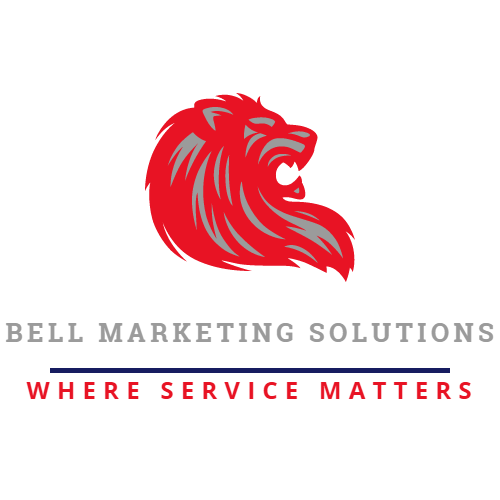
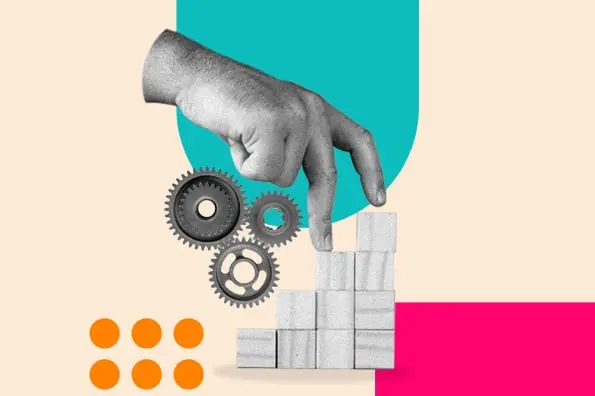
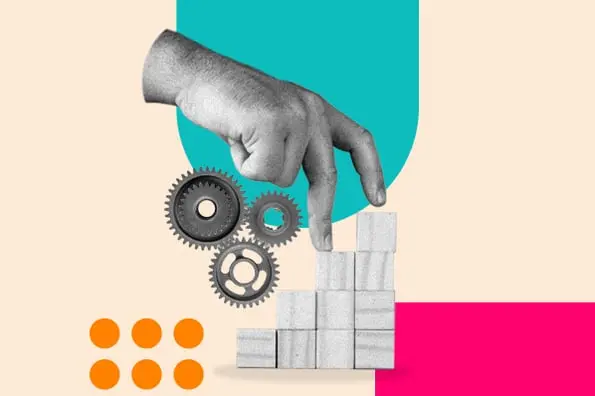
![→ Download Now: Free Product Marketing Kit [Free Templates]](https://no-cache.hubspot.com/cta/default/53/08b5e1f4-5d26-405b-b986-29c99bd0cb14.png)

